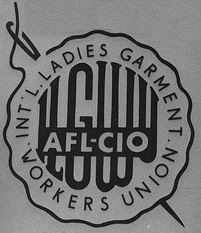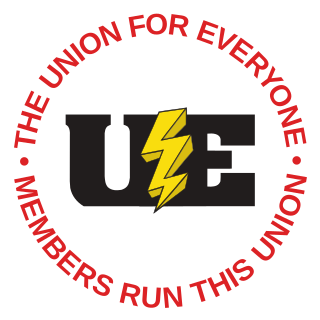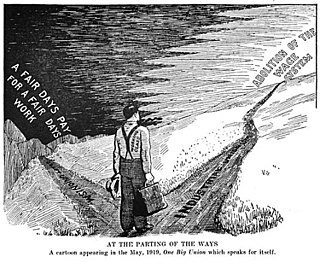Further reading
- Minutes of the Third Annual Convention of Metal and Machinery Workers Industrial Union No. 440, IWW. n.c. [Chicago]: Industrial Workers of the World, [1921].
| Merged into | Mechanics Educational Society of America |
|---|---|
| Founded | 1907 |
| Dissolved | 1950 |
| Location | |
Key people | Frank Cedervall |
| Affiliations | Industrial Workers of the World, Congress of Industrial Organizations |
| Website | Link |
The Metal and Machinery Workers Industrial Union No. 440 (MMWIU) was a labor union in the United States which existed from 1907 to 1950. It organized workers in the manufacturing industry and was affiliated with the Industrial Workers of the World (IWW).
The earliest recorded local of the MMWIU was in Bridgeport, Connecticut in 1907. A number of machinists' locals were also active under the IWW around that time, which dated from a period when a large number of craft union locals were switching their affiliation to the IWW, and whose organizational structure did not fit the IWW's vision of industrial unionism. Machinist locals existed in Kansas, Illinois, Massachusetts, New York, Pennsylvania, Virginia, Connecticut, Ohio, and Hamilton, Ontario. [1] However, these were for the most part simple descriptive labels attached to IWW branches, and it would be some time before an international MMWIU administration would be formed, which would allow the union to begin to operate as a subsidiary organization under the IWW, rather than as a direct part of it.
The IWW had organized in Ohio since 1905. [2] By 1907, there was an active MMWIU local in Cleveland, as well as a separate Machinists' branch which would exist for the next ten years, until 1917. Other metal and machinery locals were scattered throughout Ohio, in towns and cities such as Fostoria, Cincinnati, and Toledo. Its most ambitious work, however, was undertaken with the leadership of Frank and Tor Cedervall, who were to become the chief organizer of the MMWIU and Cleveland branch secretary, respectively. The Cedervalls tempered the IWW's long-ranging revolutionary vision with a focus on membership retention, addressing "bread and butter" issues like wages, and attempting to win recognition of union shops. Joining in 1931, a low period for the IWW when it had begun to enter a long-term decline after the E-P split, the Cedervalls had within six years built up a Cleveland local with 3000 members, making it the most powerful IWW local in the United States. [3] This local was built up through years of strikes, with the greatest number of strike actions between 1933 and 1940. [4]
Inevitably, then, the national MMWIU's fates would be bound up with the fate of its Cleveland membership, which boasted a presence at the Ohio Foundry Company, the Draper Manufacturing Company, the Cochrane Brass Company, the American Stove Company (Dangler Division), Cleveland Wire & Spring, and National Screw. [3]
With the passing of the Taft-Hartley Act in 1947, the MMWIU was faced with a dilemma. The Act contained explicit anti-communist provisions (later found to be unconstitutional) and banned many of the IWW's key tactics, such as secondary strikes. Unions which refused to abide by these provisions were threatened with having all legal recognition for them vanish, and shops they had organized be brought under the legal jurisdiction of unions which did sign the anti-communist pledge. [3] The international leadership of the IWW decisively refused to sign the pledge, which meant that all subsidiary unions, including the MMWIU (then the largest industrial union in the IWW) would face the serious threat of raiding from AFL and CIO unions. However, other unions, such as UE and Mine-Mill (the latter a former IWW affiliate), whose leadership did sign the pledge, would face raiding after their expulsion from the CIO, making the pledge questionable insurance at best.
Frank Cedervall, a proponent of signing the pledge for tactical reasons, then advocated that the MMWIU should disaffiliate from the IWW, as the Lumber Workers Industrial Union had as a result of the E-P split in 1924. He succeeded in leading the 1500-member Cleveland local out of the IWW, to found an independent, single-local MMWIU. This move would tear the IWW-affiliated MMWIU apart and lead to it quickly going defunct, due to the inability of its remaining membership to sustain it.
The Cedervall-led MMWIU would not stay independent long, as it would briefly affiliate with the CIO and rename itself to the Metal and Machinery Workers of America, before merging in 1954 with the Mechanics Educational Society of America, an independent union which itself had been under serious attack by the CIO before eventually affiliating with the CIO itself later that year. [5]
In 1974, the Chicago branch of the IWW started up a Metal and Machinery Workers Organizing Committee, which launched failed organizing drives at several small metal shops in the city. [4] The committee persisted, however, and ran an organizing drive at Mid-American Machinery in Virden, Illinois. With a majority of worker at Mid-American signing up as members of the union, management instated a lock-out, lawsuits against the union, and firing of several union members. Despite legal as well as direct action tactics (such as picketing equipment sales auctions and a three-month strike in 1978), the campaign dragged on until 1980, when the National Labor Relations Board forced management to negotiate with the union. By this point no union members were left at the shop, as all had either been fired or had moved on to other work, and the campaign failed. [4]
Since then, there have been no significant recorded MMWIU campaigns and the union lies defunct. The Industrial Workers of the World still lists an industrial classification metal and machinery workers under its Department of Manufacture and General Production, which keeps the possibility open for new MMWIU branches being chartered. [6] The union's papers are for the most part archived at the Walter P. Reuther Library in Detroit.

The Industrial Workers of the World (IWW), nicknamed "Wobblies", is an international labor union founded in Chicago in 1905. The nickname's origin is uncertain. Its ideology combines general unionism with industrial unionism, as it is a general union, subdivided between the various industries which employ its members. The philosophy and tactics of the IWW are described as "revolutionary industrial unionism", with ties to socialist, syndicalist, and anarchist labor movements.
Industrial unionism is a trade union organising method through which all workers in the same industry are organized into the same union, regardless of skill or trade, thus giving workers in one industry, or in all industries, more leverage in bargaining and in strike situations.
The Communist Party USA and its allies played an important role in the United States labor movement, particularly in the 1930s and 1940s, but wasn't successful either in bringing the labor movement around to its agenda of fighting for socialism and full workers' control over industry, or in converting their influence in any particular union into membership gains for the Party. The CP has had only negligible influence in labor since its supporters' defeat in internal union political battles in the aftermath of World War II and the CIO's expulsion of the unions in which they held the most influence in 1950. After the expulsion of the Communists, organized labor in the United States began a steady decline.

The American Federation of Labor was a national federation of labor unions in the United States that continues today as the AFL–CIO. It was founded in Columbus, Ohio, in 1886 by an alliance of craft unions eager to provide mutual support and disappointed in the Knights of Labor. Samuel Gompers was elected the full-time president at its founding convention and was re-elected every year except one until his death in 1924. He became the major spokesperson for the union movement.

The One Big Union is an idea originating in the late 19th and early 20th centuries amongst trade unionists to unite the interests of workers and offer solutions to all labour problems.
Craft unionism refers to a model of trade unionism in which workers are organised based on the particular craft or trade in which they work. It contrasts with industrial unionism, in which all workers in the same industry are organized into the same union, regardless of differences in skill.

The International Association of Machinists and Aerospace Workers (IAM) is an AFL–CIO/CLC trade union representing approx. 646,933 workers as of 2006 in more than 200 industries with most of its membership in the United States and Canada.

The United Steel, Paper and Forestry, Rubber, Manufacturing, Energy, Allied Industrial and Service Workers International Union, commonly known as the United Steelworkers (USW), is a general trade union with members across North America. Headquartered in Pittsburgh, the United Steelworkers represents workers in Canada, the Caribbean, and the United States. The United Steelworkers represent workers in a diverse range of industries, including primary and fabricated metals, paper, chemicals, glass, rubber, heavy-duty conveyor belting, tires, transportation, utilities, container industries, pharmaceuticals, call centers, museums, and health care.

The International Ladies' Garment Workers' Union (ILGWU), whose members were employed in the women's clothing industry, was once one of the largest labor unions in the United States, one of the first US unions to have a primarily female membership, and a key player in the labor history of the 1920s and 1930s. The union, generally referred to as the "ILGWU" or the "ILG", merged with the Amalgamated Clothing and Textile Workers Union in the 1990s to form the Union of Needletrades, Industrial and Textile Employees (UNITE). UNITE merged with the Hotel Employees and Restaurant Employees Union (HERE) in 2004 to create a new union known as UNITE HERE. The two unions that formed UNITE in 1995 represented 250,000 workers between them, down from the ILGWU's peak membership of 450,000 in 1969.

The United Electrical, Radio and Machine Workers of America (UE), is an independent democratic rank-and-file labor union representing workers in both the private and public sectors across the United States.
The Steel Workers Organizing Committee (SWOC) was one of two precursor labor organizations to the United Steelworkers. It was formed by the CIO on June 7, 1936. It disbanded in 1942 to become the United Steel Workers of America. The Steel Labor was the official paper of SWOC.

Emil Rieve was an American labor leader. He was president of the Textile Workers Union of America (TWUA) from 1939 to 1956, a vice president of the Congress of Industrial Organizations (CIO) from 1939 to 1955, and a vice president of the AFL-CIO from 1955 to 1960.

The Industrial Workers of the World (IWW) is a union of wage workers which was formed in Chicago in 1905 by militant unionists and their supporters due to anger over the conservatism, philosophy, and craft-based structure of the American Federation of Labor (AFL). Throughout the early part of the 20th century, the philosophy and tactics of the IWW were frequently in direct conflict with those of the AFL concerning the best ways to organize workers, and how to best improve the society in which they toiled. The AFL had one guiding principle—"pure and simple trade unionism", often summarized with the slogan "a fair day's pay for a fair day's work." The IWW embraced two guiding principles, fighting like the AFL for better wages, hours, and conditions, but also promoting an eventual, permanent solution to the problems of strikes, injunctions, bull pens, and union scabbing.

Wyndham Mortimer was an American trade union organizer and functionary active in the United Auto Workers union (UAW). Mortimer is best remembered as a key union organizer in the 1937 Flint Sit-Down Strike. Mortimer was the First Vice President of the UAW from 1936 to 1939. A member of the Communist Party USA from about 1932, Mortimer was a critic of the efforts of the conservative American Federation of Labor to control the union and was a leader of a so-called "Unity Caucus" which led the UAW to join forces with the more aggressive Congress of Industrial Organizations (CIO).

The Congress of Industrial Organizations (CIO) was a federation of unions that organized workers in industrial unions in the United States and Canada from 1935 to 1955. Originally created in 1935 as a committee within the American Federation of Labor (AFL) by John L. Lewis, a leader of the United Mine Workers (UMW), and called the Committee for Industrial Organization. Its name was changed in 1938 when it broke away from the AFL. It focused on organizing unskilled workers, who had been ignored by most of the AFL unions.
The International Association of Sheet Metal, Air, Rail, and Transportation Workers (SMART) is a North American labor union headquartered in Washington, D. C., was chartered by the AFL–CIO in 2013. The product of a merger between the Sheet Metal Workers’ International Association (SMWIA) and the United Transportation Union (UTU), SMART represents over 210,000 sheet metal workers, service technicians, bus operators, engineers, conductors, sign workers, welders, and production employees, among others, throughout the United States, Puerto Rico, and Canada. The Transportation Division represents employees on Class I railroad, Amtrak, and regional and short line railroads; bus and mass transit employees on some 45 transit systems; and airline pilots, flight attendants, dispatchers and other airport personnel. The Division's 500 local unions organize conductors, brakemen, switch men, ground service personnel, locomotive engineers, hostlers, and railroad yard masters, as well as bus drivers and mechanics.
The Mechanics Educational Society of America (MESA) was an independent trade union of tool-and-die-makers. First active in the automobile industry of greater Detroit, Michigan, MESA was founded in 1933 and was "the first union to effectively establish itself in what had been a traditionally open shop strong, Detroit's mass production automobile industry." MESA's general secretary was English immigrant Matthew Smith.
Frans Reinhold Cedervall (1904-1996) was a Swedish-American plasterer and labor organizer most well known for his time as a leading figure in the Industrial Workers of the World in Cleveland, Ohio. He was the lead organizer of the Metal and Machinery Workers Industrial Union and leader of its Cleveland Local 440.
The 1913 Studebaker strike was a labor strike involving workers for the American car manufacturer Studebaker in Detroit. The six-day June 1913 strike, organized by the Industrial Workers of the World (IWW), is considered the first major labor strike in the automotive industry.
The 1916 Hamilton machinists' strike was a labour dispute in Hamilton, Ontario, Canada involving between 1,500 and 2,000 workers employed in the manufacturing of munitions and other materials for World War I. It began on June 12 and involved those employed at all of the major manufacturers, including the National Steel Car Company, the Steel Company of Canada, Dominion Steel Foundry, Canadian Westinghouse Electric & Manufacturing Company, Fensom Elevators. Involving members of the International Association of Machinists, Amalgamated Society of Engineers, and unorganized workers, it ended in defeat for Hamilton's machinists.